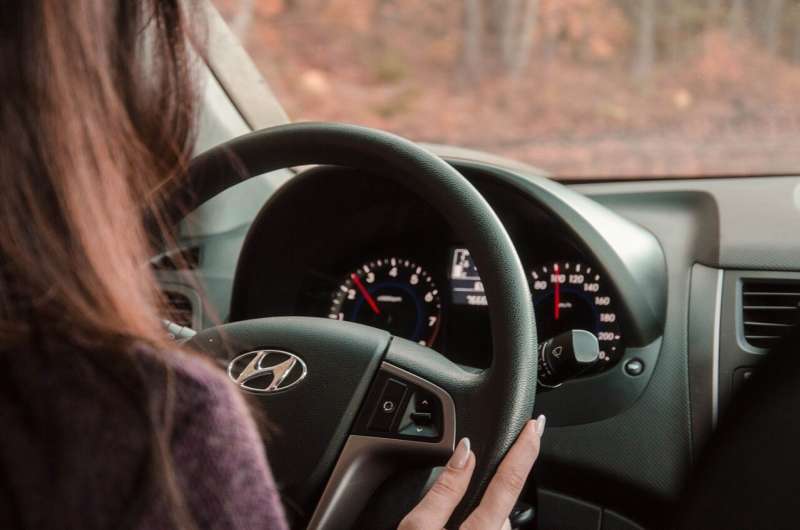This article has been reviewed according to Science X's editorial process and policies. Editors have highlighted the following attributes while ensuring the content's credibility:
fact-checked
trusted source
proofread
Researchers find barriers to driver training and licensure, especially among low-income teens

Researchers from the Center for Injury Research and Prevention (CIRP) at Children's Hospital of Philadelphia (CHOP) and the Stuart Weitzman School of Design at the University of Pennsylvania have found that teenagers living in lower-income areas of the Columbus, Ohio metro area are up to four times less likely to complete driver training and obtain their driver's license before age 18.
Long travel times to driving schools also impacted enrollment in driver education, affecting those from both higher- and lower-income areas.
The findings, published in the journals Accident Analysis and Prevention and Findings, were also presented during the Association for the Advancement in Automotive Medicine Annual Scientific Conference, in Indianapolis, IN on October 4, 2023.
Motor vehicle crashes remain a leading cause of death for teens, and the highest lifetime crash rates occur within the first year of licensure. Graduated Driver Licensing (GDL)—a system that helps to address inexperience by providing teens with the opportunity to gain experience in lower-risk driving situations—and driver education can help to reduce this crash risk.
According to other recent research conducted by CHOP in Ohio, new drivers licensed before age 18 who are subject to mandatory driver education, including behind-the-wheel training and GDL restrictions, were less likely to crash than drivers licensed at age 18 who are exempt from these requirements.
For this study, researchers analyzed whether living in lower-income neighborhoods and neighborhoods farther from driving schools reduces the likelihood of teens completing driver education and getting licensed before age 18. To do so, they utilized licensing data from the Ohio Bureau of Motor Vehicles on more than 35,000 applicants between 15.5 and 25 years old collected between 2017 and 2019. These data were then linked with neighborhood-level socioeconomic data collected by the U.S. Census Bureau.
"Our robust studies with licensing data show that teens residing in lower-income neighborhoods and neighborhoods that are farther from driving schools are significantly less likely to complete driver education prior to licensure when compared with their peers living in wealthier areas," said Megan S. Ryerson, Ph.D., senior author of the study, senior fellow at CIRP at CHOP, and the UPS Chair of Transportation at the Stuart Weitzman School of Design at the University of Pennsylvania.
"Improving access to driver training and education—through financial support and by expanding driving schools—should be a policy priority to make the roads safer for everyone."
The studies also found that, while teens living in the wealthiest neighborhoods are the teens most likely to engage in driver training, teens living in wealthy neighborhoods located most distant from driving schools were significantly less likely to complete driver education prior to securing their license when compared to teens from wealthy neighborhoods closer to driving schools.
These teens may have other means of transportation, such as rideshare services or family members, while teens from lower-income neighborhoods may lack travel alternatives and need to secure a driver license to access jobs and education opportunities.
Overall, these findings suggest that across the socioeconomic spectrum, there is a vital need to increase accessibility to driver training and licensure.
"Access to driver education and licensing is both a road safety and transportation equity issue," said Flaura Winston, MD, Ph.D., a co-author of the study and co-scientific director of CIRP at CHOP. "All states should consider taking the steps necessary to remove barriers to driver education and licensure to ensure that all teens become safe drivers, not only those who can afford driver training and licensing fees."
More information: Xiaoxia Dong et al, Financial status and travel time to driving schools as barriers to obtaining a young driver license in a state with comprehensive young driver licensing policy, Accident Analysis & Prevention (2023). DOI: 10.1016/j.aap.2023.107198
Xiaoxia Dong et al, Residing in a Driver Training Desert leads to Delayed Licensure: Investigating the Relationship between Accessibility to Driver Training and Young Driver's Licensure, Findings (2023). DOI: 10.32866/001c.85096
Provided by Children's Hospital of Philadelphia


















